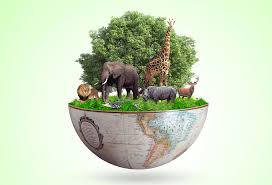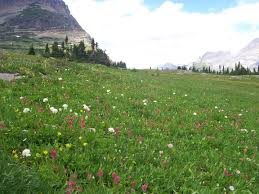The sun is the main source of energy to all life on earth. Green plants and photosynthetic bacteria need light to manufacture their food. Animals depend on plants for food. Light affects living things in terms of intensity, quality and duration.
Light intensity and quality affects photosynthesis, flowering and germination of plants while in animals affects migration, hibernation and reproduction. A photographic light meter is used to measure light intensity while the seechi disc measures light penetration in water.
Environmental Factors that Influence the Distribution and Abundance of Biodiversity
The environmental factors that influence the distribution and abundance of biodiversity include;
1. Light
The sun is the main source of energy to all life on earth. Green plants and photosynthetic bacteria need light to manufacture their food. Animals depend on plants for food.
Light affects living things in terms of intensity, quality and duration. Light intensity and quality affects photosynthesis, flowering and germination of plants while in animals affects migration, hibernation and reproduction.
A photographic light meter is used to measure light intensity while the seechi disc measures light penetration in water.
2. Temperature
Biochemical processes of most organisms function effectively within a narrow range of temperature. Temperature varies due to seasons, altitude, latitude and also diurnally especially in hot deserts.
This therefore affects the distribution of organisms in a habitat. Temperature variations influence the distribution of organisms more in terrestrial habitats than aquatic habitats.
Living organisms must develop necessary physiological and behavioral adaptations to cope with extremes of temperatures.
3. Atmospheric Pressure
The atmosphere has a definite weight and so it exerts pressure on the earth. On the surface of the earth, atmospheric pressure varies with altitude.

Variations I atmospheric pressure affects the amount of Oxygen available for respiration and of carbon (IV) oxide for photosynthesis. These two gases affect the distribution of organisms.
4. Rainfall
The main source of soil water is precipitation. The rainfall provides water to plants and animals.
Rainfall occurs due to interchange of water between earth’s surface and the atmosphere. This is known as the hydrologic cycle.
In this cycle two important things are precipitation and evapotranspiration.
Annual rainfall determines the types of vegetation in any region. We find evergreen forests in tropical regions due to heavy rainfall throughout the year. Grasslands are found in such regions where there is heavy rainfall during summer and low rainfall during winter.
In our country there are differences in the quantity of annual rainfall. Also, the distribution of rainfall in different seasons of the year is different.
Therefore, we find that vegetation types in different parts of the country are much different from each other.
We also notice different types of animals and birds in different geographical regions due to changes in vegetation and in turn, vegetation causes changes in the types of forests, animals and birds.
Different regions of the earth receive, different quantity of rain-fall depending upon the geographical features and the availability of moisture laden winds. The quantity, duration and intensity of rainfall regulate plant life.
Only a part of the rain water is used by the plants, the rest is lost in many ways like evaporation and run-off. Thus, there is a difference between the actual rainfall and the effective rainfall.
The evaporation is governed by the moisture content and the temperature of the atmosphere, and hence, in effective rainfall the total rainfall in relation to temperature is taken into account.
Read Also: On-site Municipal Wastewaters Treatment
The quantity of water that a soil holds or that infiltrates into the soil depends upon the properties of soil and type and den-sity of vegetation covering it. In a bare area, the rain drops beat the compact surface of the soil and loosen the soil particles which are washed away.
In a clay soil, the clay particles are densely packed and these stick to each other. For space is reduced and water percolation is checked.
This results in horizontal movement of water in the form of run-off, resulting in the loss of effective rainfall. Inverse is the case with a sandy soil, where in water infiltrates into the soil.
The vegetation intercepts the beating effect of rainfall and thus, water is gradually soaked in soil from where plants use it over a long period. The degree of slope is another factor for water loss. There-fore, on hill slopes, terrace cropping is practised.
5. Humidity
It refers to the amount of water vapour in the atmosphere. When humidity is high there is much water vapour and vice versa.
Humidity affects the rate at which water evaporates from the surface of organisms such as in transpiration or sweating.
This in turn affects their distribution on earth. Paper Hydrometer is used to measure or a wet and dry bulb hydrometer.
5. Wind
Wind is moving air. It increases the rate of water loss from the organisms, therefore affecting their distribution. Wind is also important in formation of rain. In deserts winds form sand dunes which can be habitats for other organisms.
Wind causes wave formation in lakes and ocean, which enhance aeration of water in this water bodies. Trees in areas experiencing strong winds may have stunted growth and distorted growth.
Wind also disperses spores and seeds hence influence disposal and migration of flying animals Wind wafts scent hence determines the positioning of hinting animals with respect to their prey in a habitat.
A wind vane or windsock is used to determine the direction of prevailing wind. Anemometer is used to measure the speed of wind.
6. Salinity
It refers to the salt concentration of water, causing a division of the aquatic environment into marine, estuarine and fresh water. Saline conditions immediately outside the body of organism pose the problem of water loss from the body to the environment.
Only animals with suitable osmoregulation adaptations can occupy such habitats. Salinity can be determined by calculating percentage of salts on water or by the acid-base titration method.
7. pH (Hydrogenion Concentration)
pH is the measure of how acidic or alkaline water is in aquatic animals or soil solution. It influences the distribution of plants and animals in soil and fresh water ponds. Some plants drive well in acidic conditions while others in alkaline conditions.
The pH of a soil can be altered by leaching fertilizers’ applied or soil exhaustion. pH is expressed in terms of pH scale by use of BDH universal indicator solution or paper and pH meter.
In summary, the distribution and abundance of biodiversity is influenced by many factors. The sun is the main source of energy to all life on earth.
Green plants and photosynthetic bacteria need light to manufacture their food. Animals depend on plants for food. Light affects living things in terms of intensity, quality and duration.
The biochemical processes of most organisms function effectively within a narrow range of temperature. This therefore affects the distribution of organisms in a habitat.
Temperature variations influence the distribution of organisms more in terrestrial habitats than aquatic habitats. Living organisms must develop necessary physiological and behavioral adaptations to cope with extremes of temperatures. The atmosphere has a definite weight and so it exerts pressure on the earth. On the surface of the earth, atmospheric pressure varies with altitude.
Rainfall occurs due to interchange of water between earth’s surface and the atmosphere. This is known as the hydrologic cycle. In this cycle two important things are precipitation and evapotranspiration.
The factor humidity refers to the amount of water vapour in the atmosphere. When humidity is high there is much water vapour and vice versa. Wind as a factor can be said to be the moving air. It increases the rate of water loss from the organisms, therefore affecting their distribution.
Read Also : On-site Municipal Wastewaters Treatment
Salinity is another factor which is referred as the salt concentration of water, leading to a division of the aquatic environment into marine, estuarine and fresh water.
High saline conditions immediately outside the body of organism pose the problem of water loss from the body to the environment.
The factors are not complete if pH scale is not included. pH is the measure of how acidic or alkaline water is in aquatic animals or soil solution. It influences the distribution of plants and animals in soil and fresh water ponds.

